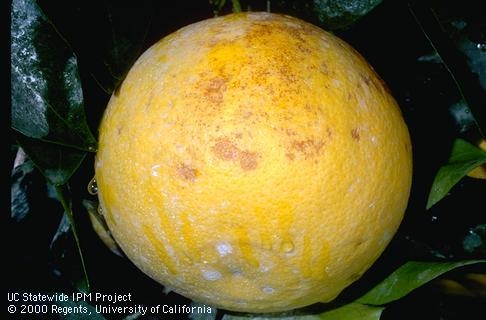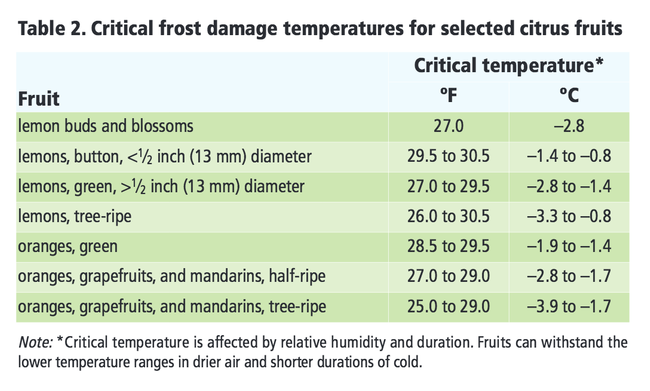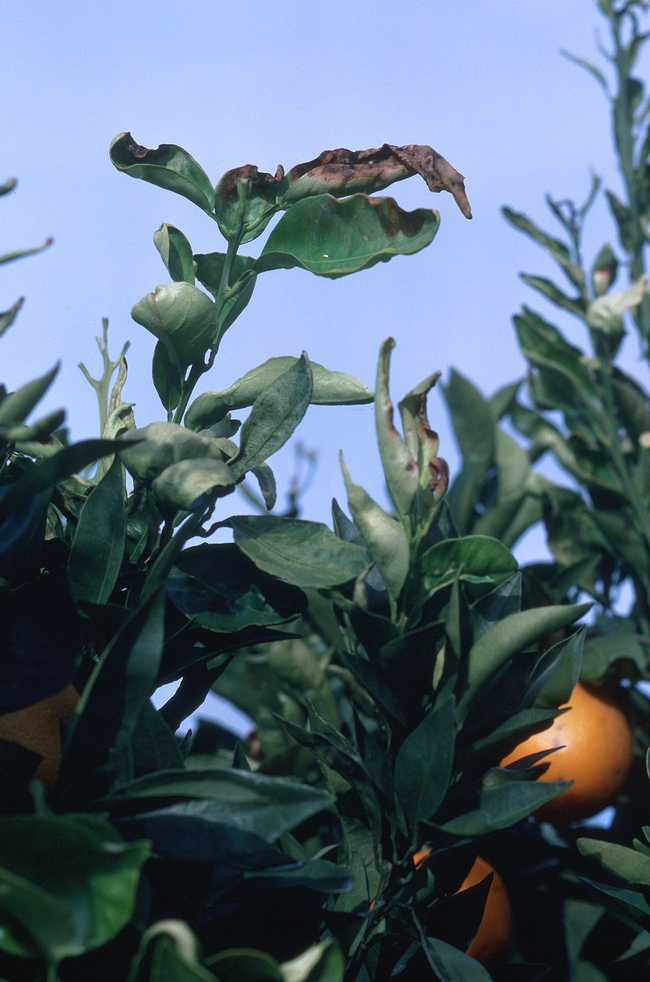Freezing temperatures damage plants by causing ice crystals to form in their cells. Frost-damaged vegetation withers and turns a dark brown or black. Ice crystals can also form in citrus fruit, causing juice vesicles inside the fruit to rupture and the fruit to dry out. Although frost-damaged fruit is edible after a freeze, it is susceptible to decay and often becomes unusable soon after the damage occurs.

Different types of citrus vary in cold hardiness. Mandarins and kumquats are the most cold hardy varieties of citrus trees. Mature mandarin trees, for example, can tolerate temperatures down to 20° for 4 hours before serious damage occurs to the wood. For Meyer lemons, the critical temperature is 22°, while oranges can sustain serious damage to the tree after 4 hours at 24°. The critical temperature for grapefruit trees is 26°. Keep in mind that these are general temperature figures. Other factors may interact with cold temperatures to influence the extent of frost damage. For example, greater damage results when cold temperatures occur over a longer time period. Mandarin fruit will tolerate a brief exposure to 24°, but several hours at 26° will begin to freeze the fruit.

Certain cultural practices can also mitigate frost damage. Healthy, well-irrigated trees are better able to endure freezing temperatures. The full, leafy canopy of a healthy tree also helps shelter the fruit. In addition, moist soil retains heat better than dry soil and can actually warm the air near the soil surface. It is also a good idea to keep the ground around trees bare during the winter months. Bare, moist soil is better able to absorb and reradiate heat than soil insulated with mulch, weeds, or other ground covers. Fertilizing and pruning both encourage new growth, and delicate new growth is far more frost-sensitive than mature foliage. Thus, pruning and fertilizing of citrus trees should occur in the spring and early summer in order to give the new vegetation time to mature and harden off before cold weather sets in.

Frost-sensitive young trees can be protected by wrapping them with insulating material from the ground up to the main branches. In frost-prone areas, you might also consider covering trees that are one to three years old entirely, using a light material to trap heat being radiated by the ground. A frame or stakes should be used to minimize contact between the cover and leaves because ice may form where the cover touches any leaves. Sheets, burlap, or tarps are a better choice of cover material than plastic because plastic transfers more heat and if leaves come in contact with it they are more likely to freeze. The cover should extend as close to the ground as possible and be removed the next morning after the temperature rises.
If trees do show signs of frost damage, resist the urge to prune out “dead” wood in the early spring. Allow a few months for the trees to recover with the return of warm weather. Once new growth appears, the actual extent of the frost damage will be apparent and frost-killed branches can be removed without accidentally pruning out living material.
For more information download the free UC ANR publication 8100 on Frost Protection for Citrus and Other Subtropicals.
UC Master Gardeners of Butte County are part of the University of California Cooperative Extension (UCCE) system. To learn more about us and our upcoming events, and for help with gardening in our area, visit our website. If you have a gardening question or problem, email the Hotline at mgbutte@ucanr.edu (preferred) or call (530) 538-7201.